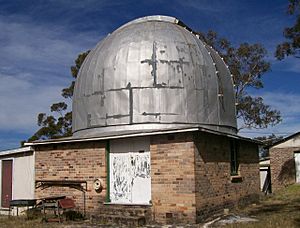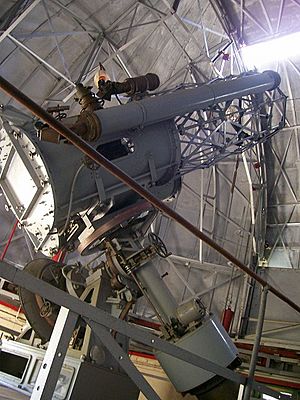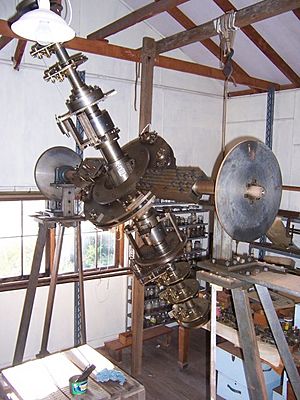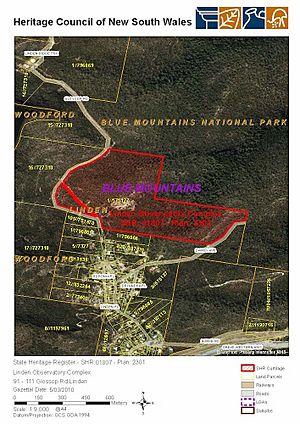Linden Observatory Complex facts for kids
Quick facts for kids Linden Observatory Complex |
|
|---|---|
 |
|
| Location | 91–111 Glossop Road, Linden, City of Blue Mountains, New South Wales, Australia |
| Built | 1938–1948 |
| Architect | Ken Beames |
| Owner | Linden Observatory Trust |
| Official name: Linden Observatory Complex; K Beames Engineering Co | |
| Type | State heritage (complex / group) |
| Designated | 5 March 2010 |
| Reference no. | 1807 |
| Type | Observatory |
| Category | Scientific Facilities |
| Builders | Ken Beames |
| Lua error in Module:Location_map at line 420: attempt to index field 'wikibase' (a nil value). | |
The Linden Observatory Complex is a special place in Linden, Australia. It used to be an observatory and a factory for making super-accurate optical tools. Today, it's a home, a museum, an observatory, a learning center, and a meeting spot.
This amazing complex was designed and built by a man named Ken Beames between 1938 and 1948. It's also known as K Beames Engineering Co. The Linden Observatory Trust now owns the property. It was added to the New South Wales State Heritage Register on March 5, 2010, because of its important history.
Contents
History of Stargazing
How Astronomy Began
Astronomy, the study of space, is one of the oldest sciences. Ancient cultures watched the sky with their eyes. They used the Sun, stars, and planets to create calendars. These calendars helped them with farming and special events.
The Chinese made some of the earliest sky observations. Around 600 BC, they noticed that the Moon had regular eclipses. They thought a hungry dragon was attacking the Moon. People would make loud noises to scare the dragon away!
In ancient Sumer and Assyria, priests watched the sky. They used what they saw to predict the future. Later, in Babylonia, people became very good at observing the sky. They learned to predict when things would happen in space using math. Their work helped shape astronomy in many parts of the world.
Early Models of the Universe
Around 400 BC, Greek astronomers created a 3D model. It showed how planets moved around the Earth. For a long time, people debated if the Earth or the Sun was the center.
Then, Nicolaus Copernicus suggested a new idea. He used math to show that planets revolved around the Sun. Galileo Galilei and Johannes Kepler later built on his ideas.
The Invention of the Telescope
Before the 1600s, astronomers only used their eyes. But in the early 17th century, a new tool changed everything. Hans Lipperhey invented the telescope. Galileo Galilei quickly improved it.
In 1610, Galileo used his telescope to make amazing discoveries. He found four moons orbiting Jupiter. This was the first time anyone saw a moon moving around another planet! Galileo also saw that Venus had phases, like our Moon. This helped prove that Earth moves around the Sun.
Johannes Kepler, who lived at the same time as Galileo, supported his findings. Kepler was the first to try to predict how planets move using physics. His research led to his "Epitome of Copernican Astronomy" in 1615. In it, he shared his three laws of planetary motion. These laws described a solar system where planets orbit the Sun.
By 1687, Isaac Newton connected physics and astronomy. He realized the same force that pulls objects to Earth also keeps the Moon in orbit. He called this the law of universal gravitation.
Astronomy in New South Wales
In 1768, Captain Cook sailed from England to Tahiti. He went there to watch Venus pass in front of the Sun. This observation helped measure the distance between Earth and the Sun. On his way back, Cook explored and mapped the east coast of Australia.
In 1788, the First Fleet arrived in Australia. With them was Lieutenant William Dawes. He loved astronomy and brought all the tools needed for an observatory. Dawes set up his "tent-observatory" in Sydney Cove. He hoped to see Halley's Comet in 1789, but he didn't. The area where he set up is now called Dawes Point.
In 1821, Governor Thomas Brisbane started an observatory in Parramatta. He and his assistants began mapping the southern skies. Brisbane filled the observatory with the best tools and a science library. This observatory worked until 1847. Its discoveries were Australia's first big contribution to world astronomy.
In 1858, the Sydney Observatory was built. This was the first government-funded observatory in Australia. It had a time-ball tower and a dome for a telescope. Other observatories were built in Melbourne, Adelaide, and Perth by the late 1800s.
Amateur Astronomers and Ken Beames
In the late 1800s, many astronomy groups started in Australia. A strong community of amateur astronomers grew. These hobbyists built their own observatories and made huge contributions.
John Tebbutt was a famous amateur astronomer. He saw a spectacular comet in 1858 and became hooked on astronomy. In 1861, he was the first to discover the "Great Comet." Tebbutt built his own observatory in Windsor in 1864. He made important observations of the southern skies.
Ken Beames, who built the Linden Observatory, was part of this tradition. He was a "master" amateur astronomer. Unlike others, Ken Beames loved designing and building telescopes. He didn't focus on just observing the sky.
In the 1930s, 40s, and 50s, Beames was one of the only people in NSW making telescopes. He said he made over 450 telescopes! These ranged from 6 inches to 24 inches in size. This was unusual because most telescopes were imported back then.
Beames' work was praised by both amateur and professional astronomers. His telescopes were masterpieces of engineering. The 24-inch telescope he finished in 1939 was the largest amateur or professional telescope in NSW. It held this record until the 1960s. His 24-inch telescope was also one of the first in Australia to use electric motors. These motors helped move the telescope and its dome.
Beames also designed other optical tools. For example, he made a "blink comparator" for the Riverview College Observatory in 1939. This tool is still there today. It was likely the first of its kind made in Australia.
Who Was Kenneth Beames?
Kenneth Beames was born in Gilgandra in 1899. He started as a telegram boy and learned Morse code. After World War I, he trained in electrical and mechanical engineering. He then became a telephone technician.
In 1924, he started a business making wireless sets from his home. His business grew to include other electrical items. By the 1930s, it was called Ken Beames Engineering Company.
In the 1930s, Beames started studying optics and math. In 1934, he built his first telescope, a 6-inch reflector. Later, he began work on a huge 24-inch telescope. He got the glass from England and built a machine to grind and polish it. The telescope was ready by 1939, but he didn't put it together until after World War II.
During the war, Beames used his skills to help make optical parts for weapons. He made sighting telescopes and signal lamp reflectors for the Royal Australian Navy and British Navy. He also made parts for Mosquito bombers.
After the war, Beames wanted to set up his 24-inch telescope away from city lights. He first put it in Lisarow in 1946. But the skies there were too cloudy. So, in 1948, he bought land in Linden in the Blue Mountains. His friend, Albert York, built the brick base of the observatory.
Over the next ten years, Beames designed and built the dome. He also created the electrical control systems and even wound his own special motors. He built most of the machines needed for the telescope in his workshops. Finally, by 1959, the 24-inch telescope was ready to use.
Beames also worked on a large planetarium in the 1960s. He designed it himself, adding new ideas to improve it. He wanted it to be the center of an astronomy education center. He worked on it until the mid-1980s when he became ill.
Besides his astronomy work, Ken Beames continued his manufacturing business. He made parts for Leyland buses from the 1940s to the 1980s. This work helped pay for his telescope projects. He also made beautiful personal items, like a brass clock and a book with brass pages.
Ken Beames was very helpful to other amateur telescope makers. He gave them advice and materials. He even built and donated equipment to the Port Macquarie Observatory.
Ken Beames' business closed in 1986, and he passed away in 1989. But the observatory is still used by amateur astronomers today.
What You'll Find at Linden Observatory
The observatory is on a large piece of land in the Blue Mountains. The main parts of the complex include:
- The Observatory building, which holds the 24-inch telescope.
- A building with a sliding roof, housing a 30-inch telescope.
- A machine shop where the planetarium instrument is kept.
- A metal workshop, now used for meetings and telescope storage.
- A storeroom.
- A special building with a constant temperature.
- Outdoor areas with concrete pads for telescopes.
- Ken Beames' former house.
All the buildings, except the sliding roof dome, are from Ken Beames' time. They hold many historical items.
The main telescope is 24 inches wide. It uses mirrors to gather light. The telescope tube is made of aluminum and a special lattice design. Electric motors help move the telescope. It sits on a large brick base inside a 3.7-meter rotating dome. The dome has steel shutters that open and close with motors.
The Observatory building also has Beames' first telescope from 1934. It's made of brass and is a beautiful piece of work. You can also see other lenses and electrical equipment Beames built.
The workshops on site hold machines from Beames' engineering business. One workshop was for sheet metal and still has tools like lathes. Another workshop has machines Beames designed to make optics for World War II.
The main workshop is mostly unchanged from the 1940s and 1950s. It has many lathes and tools. This workshop also holds the partly finished planetarium. This planetarium is the only one designed and built in Australia. Other planetariums in Australia were imported from Germany.
There's also a newer 30-inch telescope built around 2002. It's in a separate building with a sliding roof.
Condition of the Observatory
The historic 24-inch telescope is in good working order. Its mirrors were even re-coated by the Mt Stromlo Observatory as a gift to Ken Beames. Some of Beames' custom electrical equipment no longer works. The machines in the workshops show signs of not being used, but they can likely be fixed.
Drawings, documents, and notebooks need care to keep them from falling apart. The collection of tools, machines, and drawings is very complete. It shows all the different skills Ken Beames had.
Changes Over Time
- In the 1980s, Beames changed the power system for the dome and telescope.
- A new electrical system was installed in 2008 after lightning damage.
- A 30-inch telescope was added in 2002 for public viewing.
- Smaller 8-inch and 12-inch telescopes were bought in 2005 and 2007. These help with public viewing and education.
- The original storeroom was destroyed in a bushfire in 1977 and rebuilt in 1978.
Why Linden Observatory is Important
The Linden Observatory is very important to the history of New South Wales. It's a rare example of an amateur astronomy complex from the 20th century. It includes telescopes, a dome, and workshops where all the tools were made.
This observatory shows how skilled and creative Ken Beames was. He was one of the few people in Australia making instruments in the early to mid-1900s. Most professional and amateur tools were imported. Beames' work was highly respected and greatly helped astronomy in NSW. It also shows how amateur and professional astronomers worked together over many years.
Ken Beames also helped Australia during World War II. His skills in making optical parts were very important for producing military equipment.
The 24-inch telescope made by Ken Beames was the largest and most advanced in NSW from the late 1930s until the mid-1960s. It was also one of the first in Australia to use electric motors to operate the telescope and dome.
The complex is still complete with the observatory, instruments, drawings, and machines. This makes it a valuable place for research. It can help us understand astronomy and its history in NSW.
The Linden Observatory Complex was added to the New South Wales State Heritage Register on March 5, 2010.
Historical Significance
The Linden Observatory is important because of its history. Ken Beames' 24-inch telescope was a big deal in Australian telescope making. It was the largest Australian-made telescope in NSW for many years. It's still considered one of the most important amateur-built telescopes in Australia.
Beames was one of the few Australian telescope makers at the time. He made about 450 telescopes! His 24-inch telescope was also one of the first in Australia to use electric motors.
Connection to Important People
The Linden Observatory is important because of its connection to Ken Beames. He built the observatory, its telescopes, and all the equipment. Ken Beames was known as a master instrument maker. He built the largest Australian telescope in NSW before professional ones were made in the 1960s. He also made the first Australian-made Blink Comparator.
Beames was an active member of the British Astronomical Association. His colleagues respected him greatly for his work. They called him "one of Australia's most accomplished telescope makers."
Even though he wasn't a professional astronomer, his skills were highly valued. His telescopes and observatory were admired by both amateurs and professionals.
Ken Beames also helped a lot with making military equipment during World War II. His rare skills in optics were used to make lenses for signal lamps and telescope sights for the Australian and British Navies.
Creative and Technical Achievements
The Linden Observatory shows amazing technical skill. Ken Beames used many engineering skills to build the telescope. These included designing instruments, drawing plans, building, making mirrors, working with electronics, and more.
Some of his telescope designs were very new for the time. For example, he controlled airflow inside the telescope tube. He also used clocks to keep the motor drive in sync with Earth's rotation.
The planetarium, which Beames started in the late 1950s, was his own design. It was the first and possibly only attempt to build such a machine in Australia. This shows a huge technical achievement.
Beames' workshop is still mostly intact. It has his tools, custom-made machines, and parts. These show how he solved problems, like making many high-precision items. All the things Ken Beames built show incredible craftsmanship.
The items Beames made for personal use or as gifts also show his skill. These include brass jewelry boxes, miniature working cannons, a brass grandfather clock, and a book with brass pages.
This complete complex helps us study engineering and optics from the mid-20th century.
Community and Social Importance
The Linden Observatory is important for its connection to amateur and professional astronomers. Many people visited Ken Beames to learn from him. His skills in engineering and telescope-making inspired many. Some visitors said their childhood visits led them to careers in science.
Beames also worked with scientists from the Riverview Observatory and Mt Stromlo Observatory. He also helped scientists at the CSIRO Physics Lab.
Ken Beames wanted the site to be an astronomy education center. Today, the trustees are working to make that happen. Amateur astronomers still use the site regularly. They even discovered two supernovas there!
Research Potential
The Linden Observatory is important for research. Its buildings and collection of items, like drawings, equipment, and World War II optics, offer many research chances. You can learn about:
- The history of telescope making in Australia.
- How the Linden telescope was built.
- Making optical instruments in Australia.
- Making optical military equipment in WWII.
- The history of amateur astronomy in Australia.
The site continues to be a place for learning and practicing amateur astronomy.
Rare and Unique Aspects
The Linden Observatory is rare because it's a privately owned historic observatory in Australia. Other examples include Tebbutt's observatory in Windsor and the Ballarat Observatory in Victoria. Linden's collection of workshops and materials, all linked to Ken Beames, makes it unique in Australia.
Amateur-built telescopes of this size (24 inches) with professional-grade mounts are still very rare. The only older example in Australia is in Victoria. The 30-inch telescope at Linden is the largest publicly accessible telescope in Australia.
The observatory is also the closest to Sydney that still has good "dark sky" viewing. This means it's great for serious amateur astronomy. The Sydney Observatory, for example, is too affected by city lights.
The planetarium at the observatory is an extremely rare example of an Australian-made planetarium.
No other sites in NSW have such a complete collection of tools, machines, and items related to building telescopes and optical instruments during World War II.
Demonstrating Key Characteristics
The Linden Observatory shows what astro-mechanical, optical, and other engineering was like from the 1930s to the 1950s. The collection is unique in its size, condition, and quality.
The discoveries made at Linden, like variable stars and supernovas, are typical of what amateur astronomers contribute. Being a "dark sky" site allows for high-level amateur work.
The Linden complex is similar to "Stellafane" in America. Stellafane is also a collection of buildings and telescopes built by one person. It's recognized as a National Historic Landmark for its role in amateur telescope making.
See also




